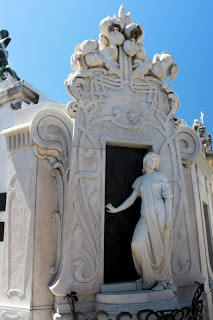The first time I ever heard of Recoleta Cemetery was in “The World” book that Steve gave me last year for Valentine’s Day. It was filled with our friends' highly recommended places to visit around the world. I remember reading Mrs. Moon from Ohio’s account of Recoleta, and I had been looking forward to seeing it with my own eyes ever since.
Recoleta Cemetery is where all of the wealthy and influential families in Buenos Aires have their final resting places. We’re talking presidents, generals, scientists, artists and professors. It’s right in the middle of the city surrounded by high walls. Walking by it on the outside, you can just barely make out the tops of statues. Upon entering the inside, you’re opened up to a maze of tall above-ground tombs, each one extremely unique and personal.
The cemetery offers free English tours twice a week, and this really enriched our experience. For me, there were two fascinating sides to the cemetery: the customs that provide the unwritten rules for operation, and the pure beauty of the tombs – each accompanied with some sort of back-story.
Upon first look, the tombs felt very similar to monuments that you would see sporadically placed around US cemeteries. But these aren’t just monuments; these are family tombs. All in all, there are 5,000 family tombs in Recoleta, and each tomb is required to have enough space to hold at least 18 coffins. Sometimes a couple of coffins might be displayed above ground level, but the majority of the coffins are stored in 2 or 3 underground rooms. They are accessed by a small staircase within the tomb that is typically covered by a grate when not in use.
Each tomb is absolutely one-of-a-kind and is designed to the family’s wishes. Some of them are small and hold just 18 caskets. Some of them are humongous, ornate, and even have family chapels inside. These are sacred places for families to come and pray and honor their loved ones. I really liked this, and wondered why we don't have this tradition in the US.
Sadly we saw a lot of small coffins, no bigger than 2 feet long, which hold the bones of deceased children. The ashes are stored in a corresponding urn.
The cemetery is extremely clean, and someone on our tour asked why it doesn’t smell. Apparently a body is placed inside a metal box that is sealed and then placed inside the wooden casket. If a metal box’s seal breaks, the caretaker will know by the smell, and the body must then be cremated. Cremation is also a necessary step if the family’s tomb becomes full and they have to cremate to make room for the next deceased family member.
There is a mix of tombs that are either extremely well maintained or forgotten by the families that own them, and thus, are dilapidated. Regardless of whether a family upkeeps their tomb and pays their annual taxes, the cemetery will never reclaim the property. It is the family’s forever until they sell it. The cemetery has long been full, but there are always a handful of properties for sale.
The tombs themselves are beautiful. It seems that every detail – from the design and stone used to the doorknobs and decorative statues – have meaning. It’s easy to stare at each tomb for awhile, just wondering about the family’s story. Here are a few of our favorites:
This is the tomb of Carlos Guido Spano, an important poet, and his family. Despite their individuality, all of the tombs throughout the cemetery at least had a geometric shape to them. This one was obviously different…it was inspired by nature. In addition to the cabin-like design, the cross is made to look like tree branches.
This tomb holds a 24-year old girl, Liliana Szaszak. She and her husband were in Innsbruck, Austria in the 1970s when an avalanche killed her in her hotel room. Her dog sits next to her, and there were fresh flowers in her hands on the day that we visited.
For us, the most memorable and haunting tomb was that of Rufina Cambaceres. In 1902 she had a case of narcolepsy, and on her 19th birthday her family found her asleep and thought she had died. She was buried alive. The following day the caretaker heard screams from inside the tomb and immediately alerted the girl’s mother. They opened up her casket to find her dead with scratch marks on her face. Her mother was so filled with guilt that they reburied her in a marble casket that lies behind a glass door, so that if she wakes up, she can be rescued. On the front of the tomb, the family placed a portrait statue of her reaching for the doorknob trying to get out. Buenos Aires now has a law that says no one can be buried until at least 12 hours after confirmed death.
The stories are endless and it would take years to learn and appreciate them all. Here's a link to a really impressive blog about the cemetery, if you're ever looking for some light reading.
It’s such a captivating place, that we’ve already gone back a second time and hope to go back a third time before we leave Buenos Aires.











Another excellent blog post! I am thoroughly enjoying your adventure! Thanks for sharing with all of us. :)
ReplyDeleteWade